Curiosity, plus an interest in Paris, has led us to many surprising finds and some unusual encounters. A recent purchase at the Toronto International Antiquarian Book Fair is a case in point.
It was a one-of-a-kind object: a handmade, illustrated, unbound book dated 1934, titled La Mode Féminine, dedicated to the School Sisters of Notre Dame by one Stewart Monaghan. Here is the description from the vendor, the Kelmscott Bookshop of Baltimore:
This unique item is a compilation of sixteen handwritten poems written in the 18th century about women, each illustrated by a pretty hand-colored original drawing of a woman in the attire of the period…. A charming item, although Mr. Monaghan’s reasons for creating and dedicating it to the School Sisters is unknown.
The handmade book was held together by boards covered in mauve cloth, edged with black lace, with pink ribbon closings. Not the sort of thing that one would expect to be dedicated to an order of nuns by a man. There had to be a story there.
When I got home, I entered the name “Stewart Monaghan” into ancestry.com, the genealogical website. The name appeared in a record from the 1930 census of the United States. Stewart Monaghan was listed as the grandson of one Cora Stewart of Baltimore, living on Guilford Street.
That made sense: the bookshop was in Baltimore, and the book itself was preserved in a cardboard box labelled Hutzler Brothers Co., a department store in Baltimore that was a fixture from 1858 to its closure in 1990.
The Stewart Monaghan in the 1930 census was about 12, so he would have been about 16 or so in 1934, when the book was created.
I Googled the head of the family, Cora Stewart, on Guilford Street in Baltimore. Her name appeared in a number of articles in the Baltimore Sun written by the columnist Jacques Kelly, who was clearly a descendant of Cora’s. I sent him an e-mail.
Bingo! Jacques Kelly responded within a few hours and explained why Stewart Monaghan had created a book dedicated to an order of Catholic teaching nuns:
Let me clear up the mystery of Stewart Monaghan. Her full name, as christened, was Margery (it sometimes appeared as Marjorie) Stewart Monaghan, my mother. She hated Margery or Marjorie and NEVER used it. Stewart was her mother’s maiden name. She was an adored child and an adored adult. Her married name was Kelly and as “Stew” Kelly she was known by the cardinal-archbishop, governor and mayor.
She was born Sept. 23, 1917, and spent 16 years, first grade through college graduation in 1939, with the School Sisters of Notre Dame in Baltimore, now called Notre Dame of Maryland University. … How such a document escaped her clutches is a miracle as she saved everything, down to homework assignments of all her six children.
There is a lesson in there about the trustworthiness of census results. And about gender roles. It is hard to imagine a young man in the 1930s creating such a book and dedicating it to a group of nuns; but quite easy to imagine a teenaged girl doing the same thing.
My next question was about the inspiration for the book. The fashion plates were stylish, and it seemed improbable that a 17-year-old girl would have the knowledge and artistic gifts to create such drawings from scratch.
In fact, they were copies or tracings. La Mode Féminine was a series of historic fashion plates, printed in Paris using the labour-intensive pochoir process (also favoured by George Barbier), and published in 1929. The creator was Henri Rouit, art director of the fashionable revue Art-Goût-Beauté.* Sets of his little books are still available on eBay and used-book websites; indeed, the complete set was sold at auction on November 12, 2013 (the starting price was 400 Euros). I, ahem, did not bid.
I wonder how Stewart came across the French fashion plates. They had been published only five years before she created her own book; in those days that was quite a rapid transfer from France to the United States. Did her family own a set? Did the convent library contain images of women in fetching hats and décolleté gowns? Did she see only the 18th-century plates, or did she have access to the full set (which ranges from the 15th to the 20th century) and choose these images specifically? I will never know.
The poetry ranges from courtly poems to romantic ballads to lover’s complaints. It is interesting to imagine this convent-schooled young woman choosing these 18th-century lyrics to go with her French fashion plates. The first one is an excerpt from The School for Scandal by Richard Sheridan. The one shown below, by Oliver Goldsmith, has an unexpected ending. I’m beginning to think that the School Sisters of Notre Dame were not your average teaching nuns.
Thanks to Jacques Kelly, I know how the story turns out. Stewart went on to university, graduating with a master’s degree, became a social worker, and in 1949, married newspaper writer Joseph B. Kelly and had six children: four girls, two boys. She lived all her life in the house on Guilford Street in which she grew up. She sounds somewhat larger than life and full of energy and interests. In a 2009 column, Kelly wrote:
She was made to order for Baltimore because of her lack of pretense and her love of people, whom she cultivated by the hundreds. She was a great worker of the telephone – her calling hour began about 9:30 at night and was accompanied by clouds of Lucky Strike cigarette smoke. Using a clipboard, she was a letter and note writer and could say much in few words. She wrote quickly and kept the impressions coming. Alongside her telephone-tobacco chair was a pile of murder mysteries, many from the Pratt Library.
She sounds like someone I would have enjoyed meeting. She died in 1993, aged 75, never having visited France.
Chances are, she forgot all about the little book she made for her teachers at the convent. It probably sat in a drawer or bookcase until someone did a clear-out and sent it, probably with other books, to the Kelmscott Bookshop, whose owners brought it to Toronto. Now it is part of my library, complete with provenance, “unknown” no more.
Text by Philippa Campsie, illustrations by M. Stewart Monaghan after Henri Rouit.
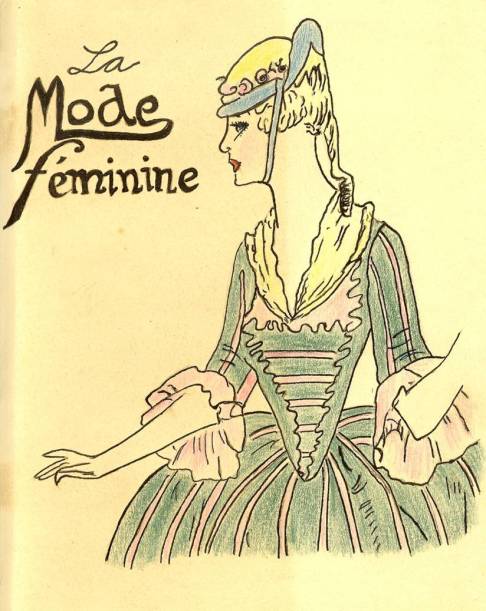







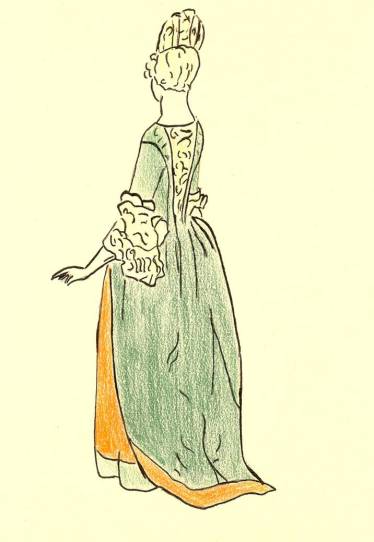



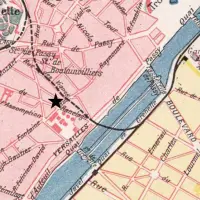
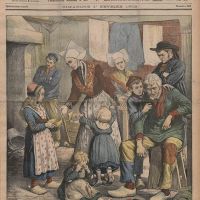

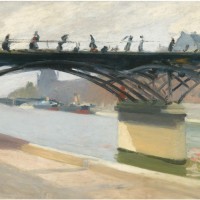

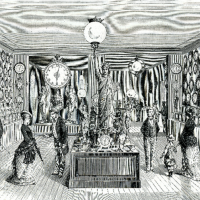
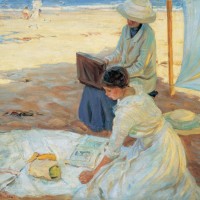











I love your posts. But I’m curious: How much did you pay for the little book?
Ah, that’s classified. But it was certainly worth it.
A beautiful little story. Thank you.
Paris changes and bookshops disappear, but I read your story on my laptop; Thank you Internet.
Heard this week that the “Salle Pleyel” is no longer to be a concert hall! Some incredible story about a limit to the number of classical concerts per year, and it is to be replaced by a modern building under construction on the edge of the boulevard périphérique, sponsored by the Mayor of Paris. It will be “his mark” before he leaves. The Salle Pleyel will be privatized and only for modern music!!!
The Salle Pleyel! Say it ain’t so!
This morning’s New York Times magazine has an article about a similar trend there: http://www.nytimes.com/2013/11/24/magazine/a-reason-to-root-for-dubai-on-the-hudson.html?ref=magazine&_r=0
Let us hope never to see “Dubai on the Seine.”
I’m afraid it is true.
First this last week the company that made “Pleyel” pianos went out of business. Now it is the turn of the Salle Pleyel.
Have you ever been to look at the area – completely rebuilt – on the banks of the Seine just west of the Bibliothèque Nationale? That is what is promised for the rest! It is called “Le grand Paris”
You’d think the powers that be might have learned a lesson after creating the Front de Seine.
In the 50s and 60s, I was schooled by School Sisters of Notre Dame in grade school (grades 1-8) and by the Sisters of St Joseph in high school (grades 9-12). From my experience, the SSND were uniformly not “average teaching nuns.” Some were kind and helpful. Others used corporal punishment (a ruler or paddle applied to the backside) on certain students. On balance, my assessment of the SSND nuns is negative.
Thank you for your comment. I attended an Anglican school rather than a Catholic school, but like you, my impressions are mixed. On balance the overall impression was positive, but I remember some difficult experiences. Stewart Monaghan clearly had a good experience, but so many people do not. Church schools are not for everyone.
Charming story, and very good detective work on your part!
Well done…. what a lot of work it involved, chasing up a hunch. I tend to think of brilliant ideas then let them go because the work would be too time consuming.
I am very impressed that Stewart went on to university, graduating with a master’s degree, became a social worker, and in 1949, married a newspaper man and had six children. What an ambitious, achieving woman!!
Just the fact that at a young age she chose a different name for herself suggests an unusual and interesting personality. Clearly she was one of a kind.